Thai Eggplant Curry Recipe
Thai eggplant curry recipe is a quick and easy dish with homemade red curry paste, perfect for your busy weeknight dinners. It’s your favorite takeout order transformed into an authentic one-pot wonder that’s ready in less than 30 minutes. Serve it over steamed jasmine rice and watch it soak up all that creamy coconut curry sauce!
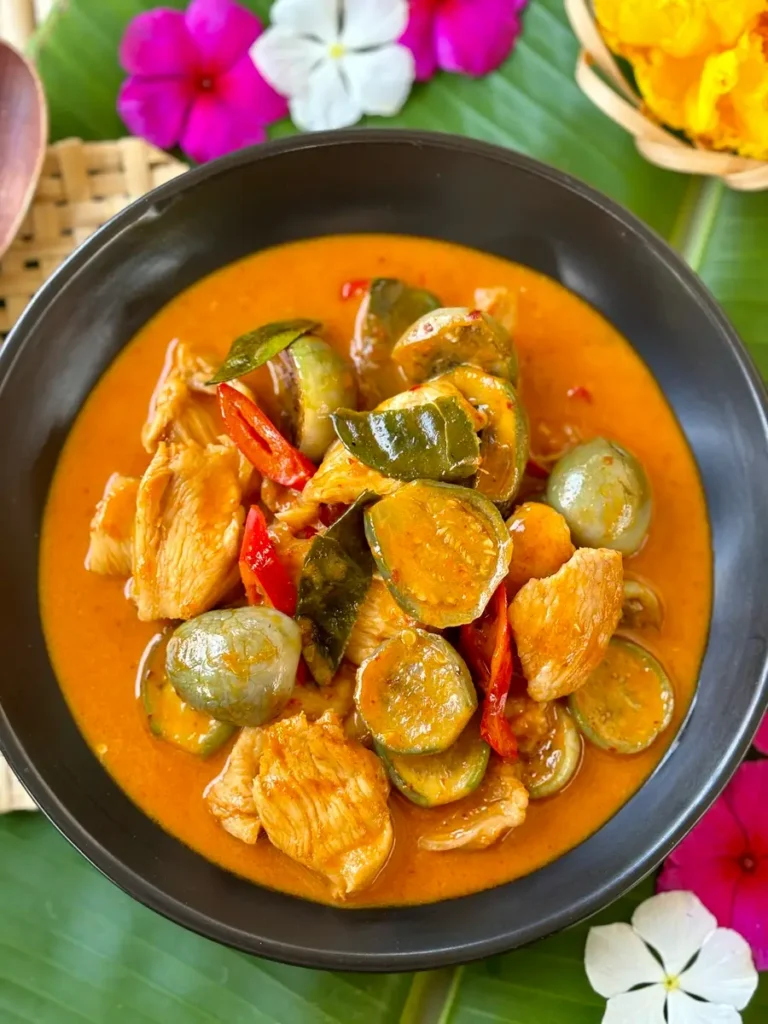
Here are some more Thai curry recipes with eggplants you can try later: authentic Thai red curry recipe, Thai jungle curry recipe (kaeng pa), and Thai green curry pork (gaeng keow wan).
What is Thai eggplant curry
Thai eggplant curry is a creamy Thai dish made with tender eggplants simmered in a rich, spicy red curry sauce. This authentic recipe combines aromatic spices, coconut milk, and fresh herbs into a creamy curry perfect for an easy meal with rice.
Thai red curry eggplant recipe
Thai red curry is known to be one of the spiciest Thai curries, on par with this vegetarian Thai green curry but definitely not as hot as kaeng som, a Southern Thai curry with its own kaeng som curry paste. Thai jungle curry is another classic in Southern Thai cuisine, with a water-based broth perfect for spice lovers.
This easy curry is an eggplant lover’s dream. The eggplants soak up all the irresistible flavors of the spicy, rich, and fragrant curry sauce. And the tender chicken pieces are the perfect partner. If chicken’s not your thing, don’t worry! I’ve got plenty of substitution ideas coming up after the instructions. Anything you put into this creamy coconut sauce will come out amazing.
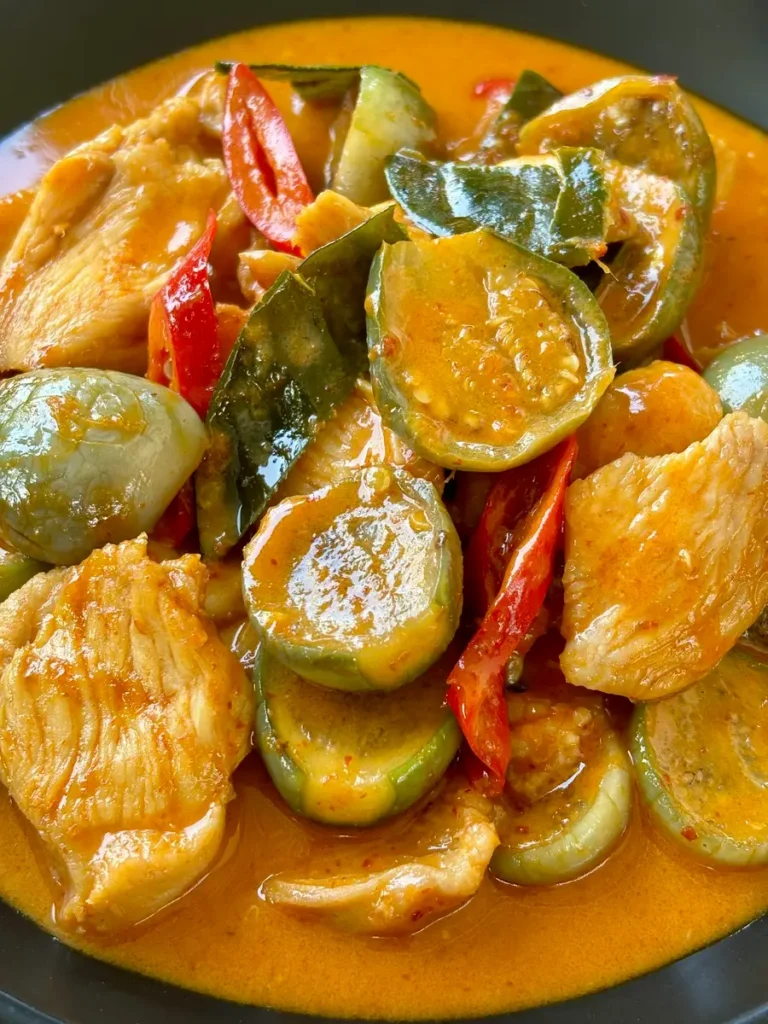
This authentic eggplant curry recipe uses the traditional method of reducing the coconut milk, this not only thickens the sauce but also brings out this rich, deep flavor from the coconut milk.
You might have seen some recipes and even Thai restaurants just quickly fry up the curry paste and then throw in the coconut milk. It’s fast, but it misses out on letting the coconut milk really meld with all those fresh herbs and spices. Don’t worry, you’re getting that full authentic flavor here!
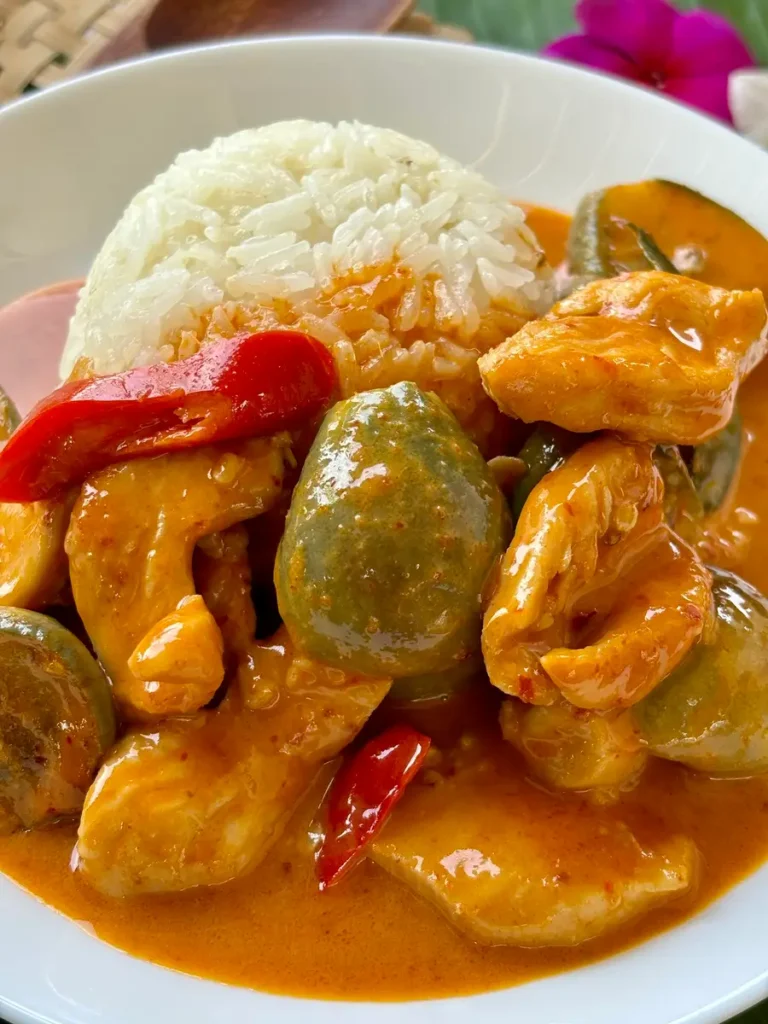
If you love it fiery, feel free to toss in some spicy Thai chilies. If you’re feeding a family with kids, keep it mild and definitely skip the extra chilies. Speaking of kids, this gang garee curry recipe for Thai yellow curry is milder and always a hit with the family, perfect for the little ones.
Thai red curry paste
If you have some spare time, use my Thai red curry paste recipe. It blends dried chilies, galangal, turmeric, lemongrass, shrimp paste, and kaffir lime into a paste better than any store-bought.
It’s a labor of love, but it definitely pays off – it gives your dishes that authentic touch and aroma that store-bought just can’t match.

I like to use a Thai mortar and pestle, but if you’re short on time, you can whip up this paste in just minutes with a food processor. It’s a healthier alternative to the jarred stuff, and making it yourself lets you control the ingredients!
My gaeng daeng recipe and Thai roasted duck curry (gaeng phed ped yang) are two more recipes in which you can use your homemade red curry paste. They’re both equally delicious! I also have authentic Thai recipes for massaman curry paste, green curry paste, and panang curry paste.
How to cook Thai eggplant in curry
Cooking Thai eggplant in curry is easy. Just add them to your curry and let the curry simmer gently until the eggplant is tender. There is no need to use oil, simply reduce the coconut milk, combine it with your curry paste, and follow up with the remaining coconut milk. Just follow the easy recipe step-by-step instructions!
How to cut eggplant for Thai curry
Cutting eggplants for Thai curry comes down to personal preference. Typically, they’re washed and then sliced into bite-sized pieces, either half-moons or quartered. For Thai curry, keep the skin on to help the eggplants hold their shape during cooking. In Thailand, we use Thai eggplants for curry.
Note: Eggplants come in a wide variety of shapes, sizes, and colors. There are globe eggplants, Japanese eggplants, and Chinese eggplants. This is a Thai red curry recipe with Thai eggplants, so the cooking time and instructions are specifically tailored for this variety.
Ingredients
Ingredients can be sourced at Asian grocery stores and Asian markets.
The exact measurements are in the recipe card at the end of this post.
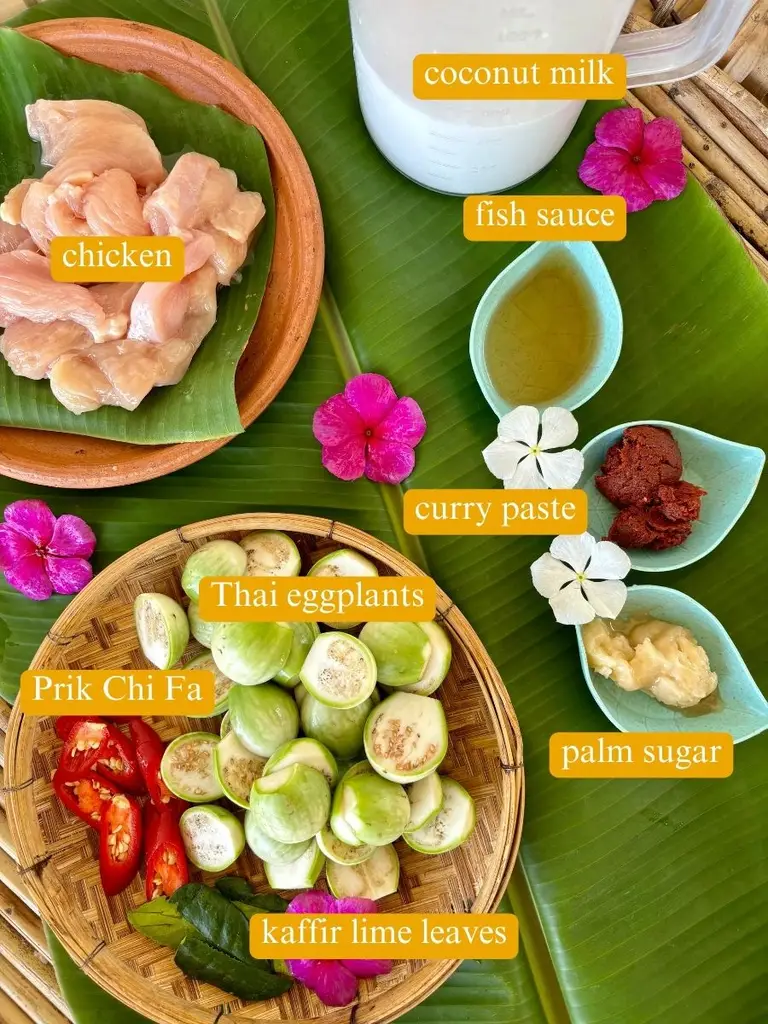
- Chicken – Boneless skinless chicken thighs are perfect – they’re juicy and rich in flavor. Chicken breast can be used as as a lean alternative.
- Thai eggplants – Thai eggplants are great for curries. They have a mild, slightly sweet taste, and they soak all the bold flavor of the curry sauce.
- Coconut milk – Opt for full-fat coconut milk, this creates a creamy curry sauce with natural sweetness that balances out the heat of chilies and spices. (not coconut milk can or coconut cream)
- Kaffir lime leaves – Also known as makrut lime leaves, they infuse the curry with a citrusy aroma that’s irreplaceable. You can find these at most Asian grocery stores. Some will have them fresh, but they’re also available dried.
- Prik Chi Fa chili – This particular type of large Thai chili pepper is a staple in Thai cuisine. It not only lends a moderate amount of heat to the curry sauce, it also infuses it with a bright red color.
- Thai red curry paste – My homemade paste is a blend of herbs and spices with a complex flavor profile. For store-bought alternatives, you can use Mae Ploy or Maesri, readily available at Asian markets and supermarkets.
- Palm sugar – Palm sugar adds a natural caramel-like sweetness that balances out the salty and spicy notes. (not white sugar, brown sugar, or others)
- Fish sauce – Fish sauce is an essential Thai condiment, bringing a salty, umami flavor to the curry sauce. It’s a staple ingredient in Thai kitchens, made of salted fish that have been fermented for up to 2 years.
Cooking instructions
Step 1: Fill a bowl with water and mix in a tablespoon of salt. Slice your Thai eggplant and rest them in the salty bath for 10 minutes. This not only keeps them from browning but also helps to remove any bitterness.
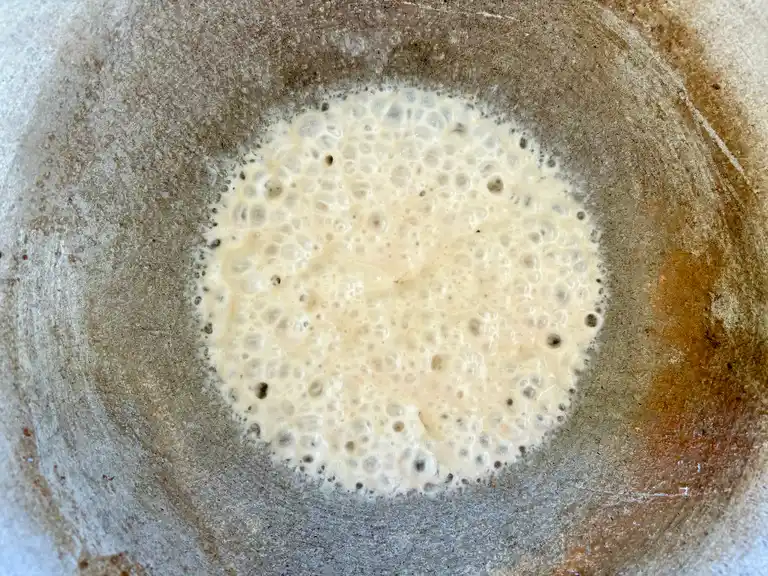
Step 2: Heat a pot or wok over medium heat. Add half the coconut milk and simmer until the sides gently bubble. This allows the coconut milk oil to naturally separate and rise to the surface.
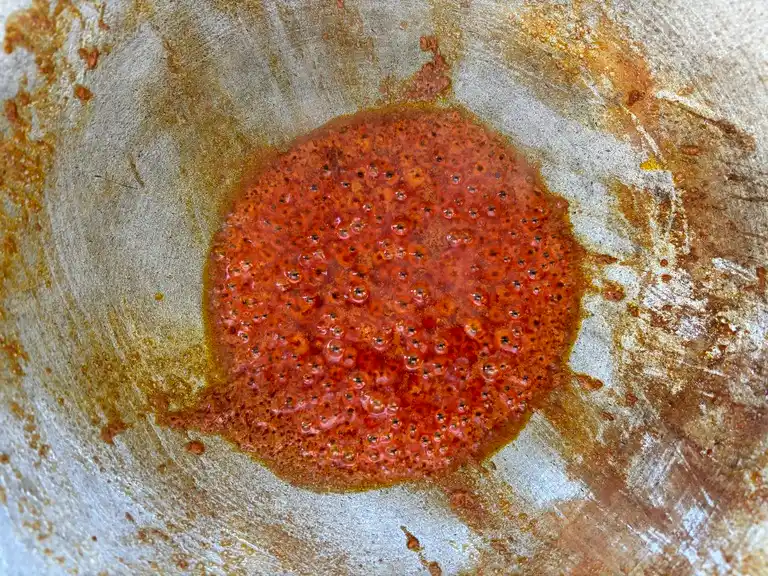
Step 3: As soon as you notice a sheen of oil starting to create a separate layer, whisk in the curry paste. Stir continuously to mix with the coconut, and follow up with the remaining coconut milk.
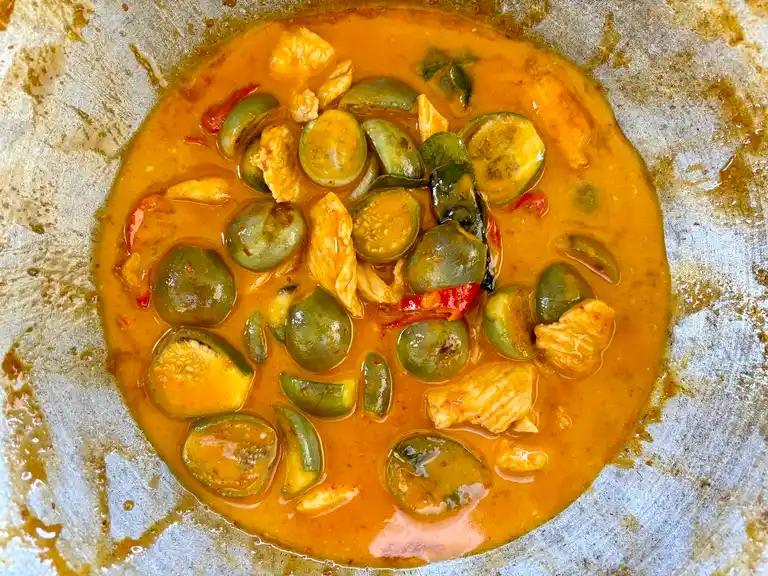
Step 4: Add the remaining ingredients: sliced chicken and Thai eggplants, fish sauce, palm sugar, Prik Chi Fa chili, and kaffir lime leaves. Let the curry simmer until the chicken is cooked, and the eggplants are tender to your liking. Avoid cooking for too long, this will make the eggplants mushy. Serve your Thai eggplant curry with steamed rice.
Kitchen tools
- Cutting board and sharp knife for prepping the vegetables and chicken
- Mortar and pestle or food processor for making the curry paste
- Measuring spoons and cups for measuring out ingredients
- Wok or pot for simmering your red Thai eggplant curry
- Wooden spoon or ladle for stirring and serving
Tips for making Thai red curry with eggplant
- Choose the right eggplant: This recipe is for Thai eggplants. If you want to use other type of eggplants, please adjust the cooking time and process accordingly.
- Use fresh ingredients: Make sure your eggplants are fresh, and try to find fresh kaffir lime leaves for the best flavor.
- Prep your eggplants: Salt and rest your eggplants in water before adding them to the curry, this draws out bitterness.
- Balance the flavors: Thai cooking is all about making it right for you. Make sure to taste-test before serving and balance the sweet, spicy, and salty notes.
Substitutions and variations
- Green curry with eggplant: Use my Thai green curry paste and create new delicious flavors with a slightly sweeter taste.
- Experiment: Experiment with different flavors. Try soy sauce as an alternative, add Thai bird’s eye chilies for spice, and feel free to add more vegetables.
- Vegetables: Add red bell peppers, sweet peppers, grilled eggplant, snow peas, bamboo shoots, carrots, zucchini, squash, broccoli, carrots, and green beans.
- Vegetarian: For a vegetarian curry, firm tofu is a great option for soaking up the rich, spicy flavors of the red curry sauce.
- Protein: Feel free to experiment with other meats like pork, beef, turkey, and duck. For seafood, try shrimp or squid. Simply adjust the cooking time accordingly.
- Fish: For a variation with fish, try my Thai red curry fish.
How to serve
Ladle your curry into a bowl and serve with jasmine rice in a separate dish. Alternatively, you can ladle your eggplant curry over a bed of steaming jasmine rice. Garnish with fresh cilantro or freshly chopped green onions. A squeeze of lime can add a zesty note.
How to store and reheat
Let your Thai eggplant curry leftovers cool to room temperature. Transfer them into an airtight container and store it in the fridge for up to 3 days.
Freezing instructions: Curries freeze like a dream. Simply freeze the curry in a freezer-safe container for up to 3 months. Thaw in the fridge overnight.
Reheating instructions: Warm it gently in a saucepan or pot over medium heat, stirring occasionally.
Frequently asked questions
Is this recipe gluten-free?
Yes, all ingredients used in this recipe are gluten-free. However, make sure to double-check the labeling of your store bought brands.
Where to buy Thai eggplant?
You can buy Thai eggplant at some Asian grocery stores and at Asian markets. Thai eggplant can be green or white with green stripes.
Authentic Thai curry recipes
- Hor mok pla recipe (Thai steamed fish curry)
- Vegetarian Thai mushroom curry
- Authentic panang curry recipe
- Thai beef panang curry recipe
- Thai massaman chicken curry
- Thai pineapple curry
Loved reading this Thai eggplant curry recipe? Please make my day by dropping a star rating and/or a comment below! Follow me on Facebook, Instagram, and Pinterest.
Thai Eggplant Curry Recipe

Ingredients
- 17 fluid ounces coconut milk
- 1.5 tablespoon red curry paste see notes
- 8.8 ounces chicken sliced thinly
- 8.8 ounces Thai eggplants halved
- 1 red spur chili
- 2 kaffir lime leaves
- 2 tablespoons palm sugar
- 1 tablespoon fish sauce
Instructions
- Fill a bowl with water and mix in a tablespoon of salt. Slice your Thai eggplant and rest them in the salty bath for 10 minutes. This not only keeps them from browning but also helps to remove any bitterness.
- Heat a pot or wok over medium heat. Add half the coconut milk and simmer until the sides gently bubble. This allows the coconut milk oil to naturally separate and rise to the surface.
- As soon as you notice a sheen of oil starting to create a separate layer, whisk in the curry paste. Stir continuously to mix with the coconut, and follow up with the remaining coconut milk.
- Add the remaining ingredients: sliced chicken and Thai eggplants, fish sauce, palm sugar, Prik Chi Fa chili, and kaffir lime leaves. Let the curry simmer until the chicken is cooked, and the eggplants are tender to your liking. Avoid cooking for too long, this will make the eggplants mushy. Serve immediately with steamed rice.
Notes
- Use the nutrition card in this recipe as a guideline.
- Use my homemade Thai red curry paste. For store-bought alternatives, you can use Mae Ploy or Maesri, readily available at Asian markets and supermarkets.
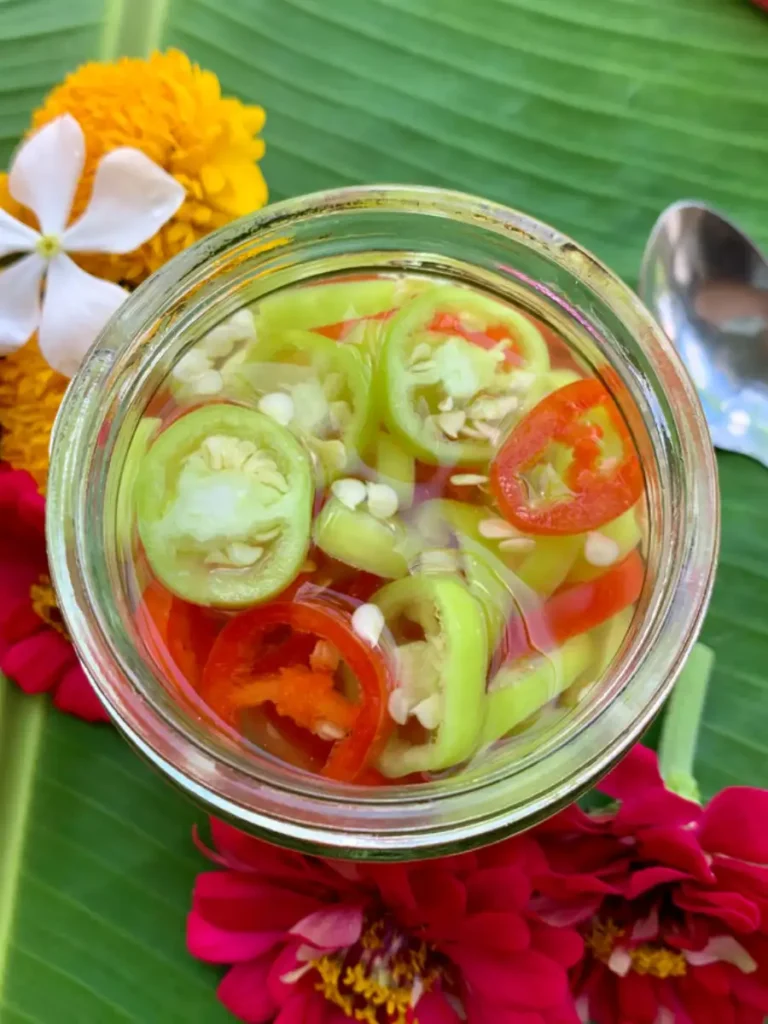
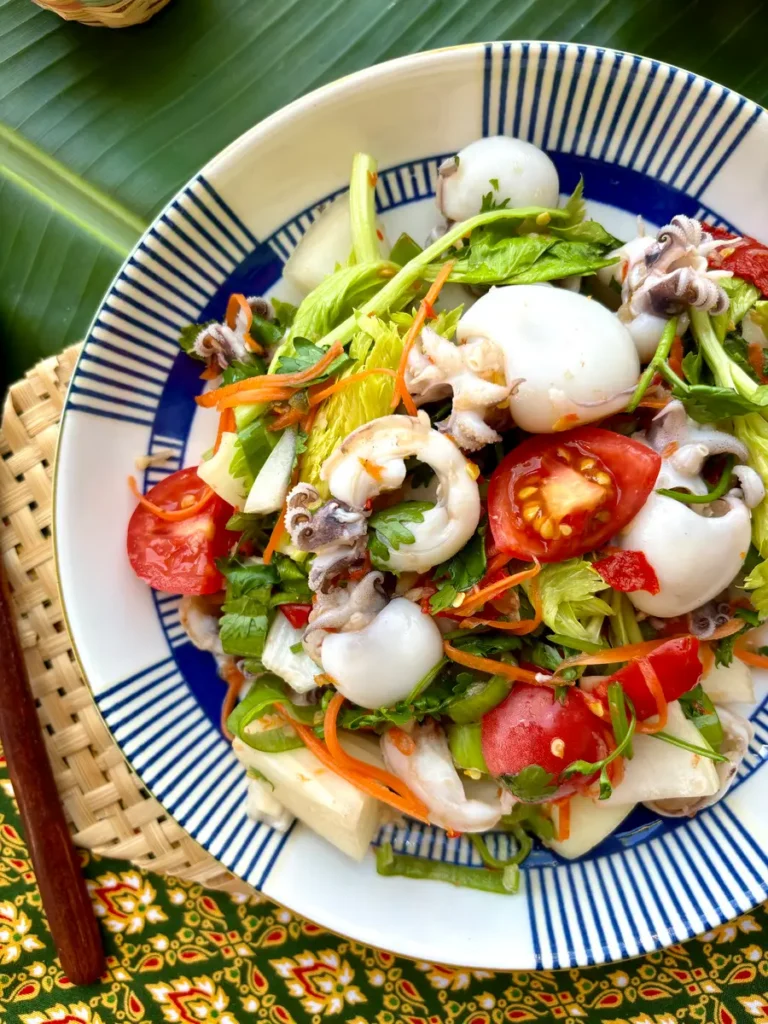
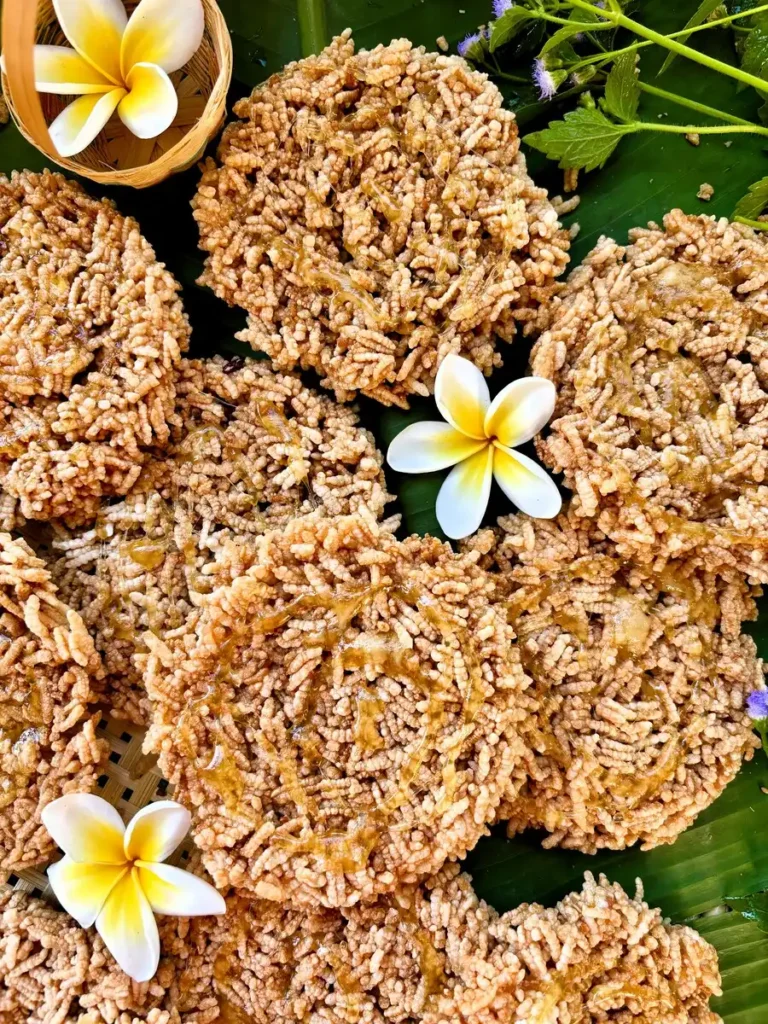
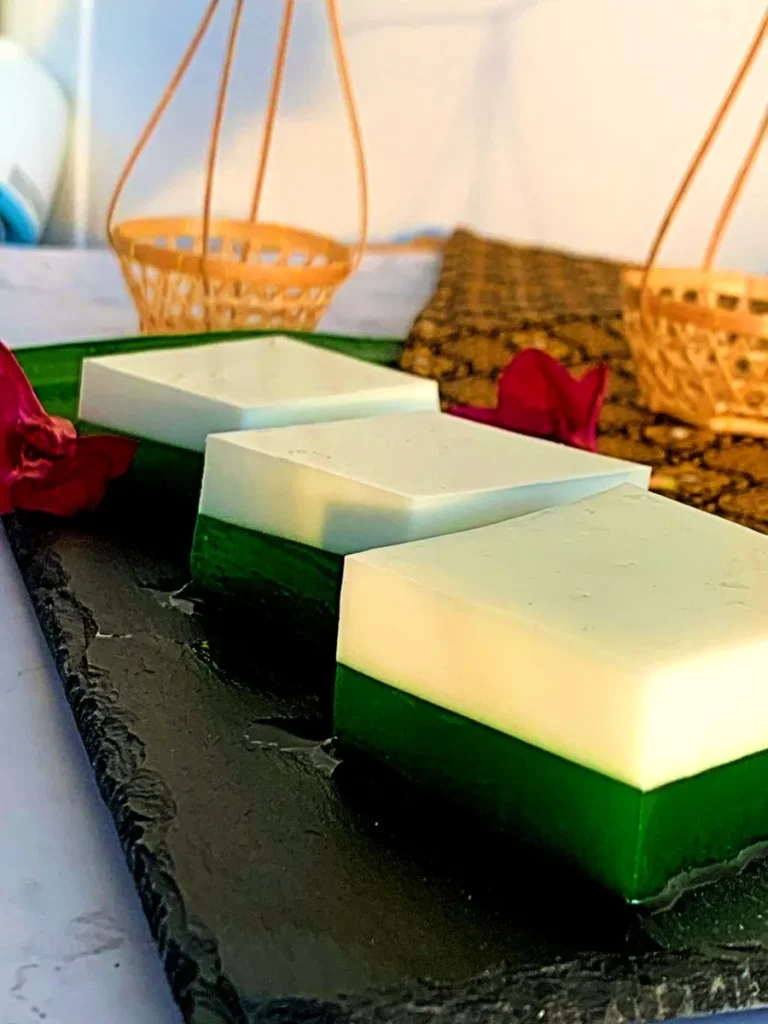
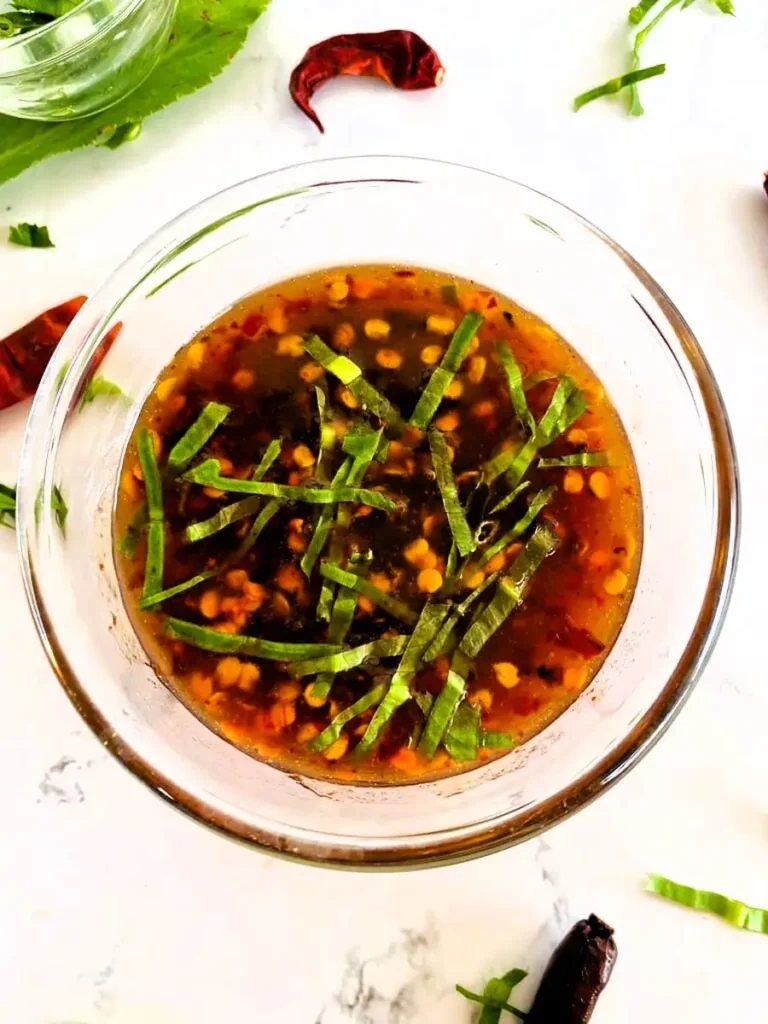
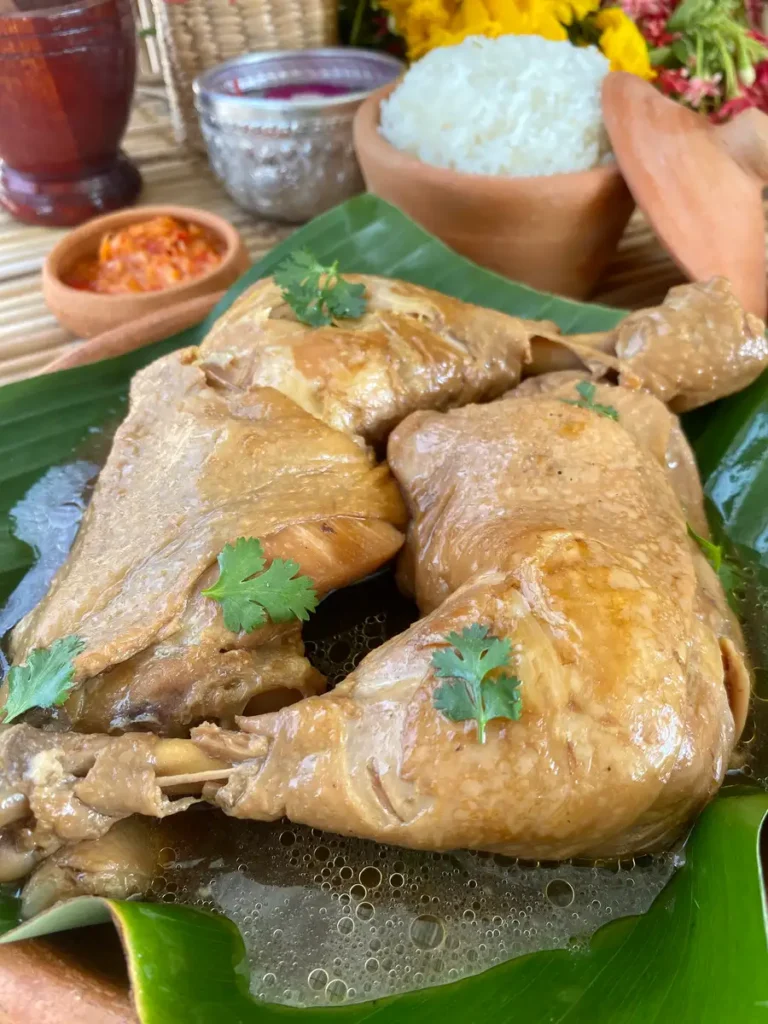
One Comment